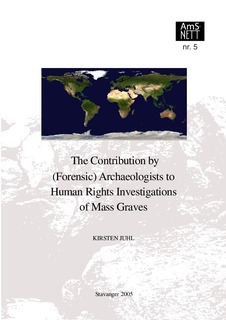| dc.description.abstract | Since the German “Nacht und Nebel” policy of World War II and their industrialised killing
of Jews and Gypsies in the Holocaust, state institutionalised, deliberate and systematic
practices of making people disappear – whether for political, religious, ethnic, cultural or
other motives – has been known as an efficient tool of war and repression. The systematic
practice of making people disappear is now known as enforced disappearance, and has lately
been recognized as a crime against humanity. Both genocide and crimes against humanity is
often associated with the use of mass graves in order to conceal the crime and also prevent
individual identification.
Over the past twenty years forensic experts, and among these archaeologists, have been
contracted or subcontracted to investigate such mass graves by truth commissions, local
courts and international tribunals, local and international human rights and family
associations in together more than forty countries all over the world.
The present study explores how excavating such mass graves may serve different purposes
related to the societal rebuilding processes in the aftermath of violent conflicts whether
internal or international, and thus contribute to societal security and safety. The focus is on
the role and contribution of archaeologists in this process. For this purpose a conceptual
distinction is made between excavating mass graves (focusing on the mass grave as an
archaeological feature) and exhuming human remains (focusing predominantly on retrieving
the human remains).
The history, principles and mechanics of scientific mass grave excavations are discussed and
illustrated with examples from Latin America, former Yugoslavia, Rwanda and most
recently Iraq, focusing on the role of archaeology as an integrated part of a multidisciplinary
forensic team work. It is demonstrated how evidence from mass grave excavations has been
important to truth commissions in Latin America (Guatemala, El Salvador, Peru), and to
cases brought before human rights courts. For example the Dos Erres case where the
Guatemalan governments was sentenced to pay reparation and provide physical and
psychological treatment to survivors and relatives, and to build a memorial. It is further
demonstrated that the evidence from excavations of mass graves is an important factor in
getting war criminals convicted, as for example in the case against Krstic, who was
sentenced to 35 years in prison based on evidence from 21 mass graves related to the
Srebrenica Massacre.
It is argued that historically two investigation strategies have been employed. In Latin
America one has integrated the excavation and exhumation concept into one investigation
concept. In former Yugoslavia one has distinguished between the excavation and exhumation
concepts, but achieved a holistic strategy through complementary institutions conducting the
investigations – the ad hoc International Criminal Tribunal for former Yugoslavia (ICTY)
and the International Commission on Missing Persons (ICMP)/the national CMPs. The
recent development of mass grave investigations in Iraq seems to introduce a third concept
and overall strategy.
It is concluded that human rights mass grave investigations have contributed significantly to
the success of national as well as international truth commissions, human rights courts,
criminal courts and tribunals throughout the world – and thus consequently to both truth and
justice. The contribution has been most evident in Latin America and former Yugoslavia.
However, the field is rapidly growing and forensic anthropology and archaeology is
3
increasingly incorporated into international crisis and conflict management strategies –
notably by the United Nations.
Human rights mass grave investigation teams have in general pursued three major purposes:
humanitarian, legal and historical purposes. Establishing a historical record – the factual
truth of what happened and in which sequence at a specific location at a specific point in
time – is paramount to pursuing the legal and historical purposes and important also to
reaching the humanitarian purpose of identifying victims. It is concluded that the
significance of the contribution by archaeologists to human rights mass grave investigations
lies with their unique ability to provide this historical record. | no_NO |
